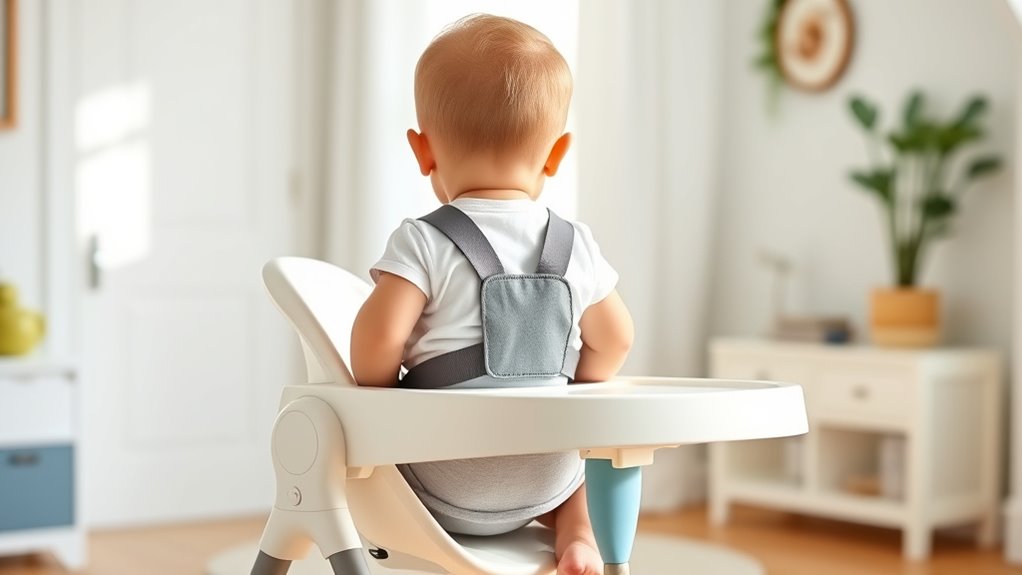To keep your child safe and promote proper feeding posture, verify the high chair is stable, well-assembled, and that safety straps are secure. Always supervise your child; never leave them unattended or near walls where climbing is possible. Position your child upright with feet supported and the tray adjusted for easy reach. Avoid loose toys that could cause choking or posture issues. Continuing with these guidelines helps create a secure and comfortable mealtime environment—there’s more to take into account for ideal safety and posture.
Key Takeaways
- Ensure the high chair is stable, properly assembled, and on a flat surface before use.
- Position the child upright with feet supported and the tray at an accessible height.
- Regularly inspect safety straps, straps are snug, and check for wear or damage.
- Never leave the child unattended or place loose items that could cause choking or posture issues.
- Promote good posture to support digestion, prevent discomfort, and encourage healthy eating habits.

Using a high chair safely and ensuring proper feeding posture are essential steps in protecting your child’s well-being during mealtime. When you focus on toddler posture, you’re helping prevent discomfort and potential long-term musculoskeletal issues. Proper chair safety means making sure the high chair is stable, sturdy, and correctly assembled. Check that all safety straps are functional and snug, keeping your child securely seated without restricting breathing or movement. Always follow the manufacturer’s instructions for assembly and weight limits. A wobbly or poorly constructed high chair can pose a risk of tipping or collapsing, so it’s imperative to regularly inspect the chair for any signs of wear or damage. By prioritizing chair safety and stability, you create a secure environment where your child can eat comfortably and safely.
Ensure your child’s safety with a stable, well-assembled high chair and secure safety straps during mealtime.
When positioning your toddler in the high chair, pay close attention to their posture. Your goal is to encourage an upright sitting position that supports proper digestion and reduces the risk of choking. Adjust the footrest so your child’s feet are supported and flat, which helps maintain stability and promotes better posture. Their hips should be slightly higher than their knees, with the back fully supported by the chair’s backrest. Avoid slouching or leaning forward, as this can cause discomfort and interfere with swallowing. Keep their tray at a height where they can reach easily without stretching or craning their neck. This promotes natural feeding movements and minimizes strain on their neck and shoulders. Ensuring the feeding posture is correct is crucial for your child’s comfort and safety.
It’s equally important to understand what NOT to do. Never leave your child unattended in a high chair, especially once they begin to push or lean forward. Always stay within arm’s reach to intervene quickly if they try to climb out or if their posture shifts dangerously. Don’t ignore signs of discomfort, such as fussiness, leaning, or slouching, which indicate that your child isn’t sitting properly. Avoid placing the high chair near walls or other furniture where they might try to escape or fall. Additionally, don’t forget to remove any loose items or toys from the tray that could interfere with your child’s posture or become choking hazards.
Ultimately, fostering good toddler posture and ensuring chair safety during mealtime creates a safe, comfortable environment. It helps your child develop healthy eating habits and physical development from a young age. When you’re attentive to these details, you’re not just preventing accidents—you’re supporting your child’s growth, comfort, and well-being during every meal.
Conclusion
Ensuring your child’s safety and proper feeding posture in a high chair is essential. Did you know that improper posture can increase choking risk by 30%? By following safety tips and encouraging good posture, you help prevent accidents and support healthy development. Keep an eye on your little one, stay vigilant, and create a safe feeding environment. Your attentive care makes all the difference in nurturing a happy, healthy eater.










